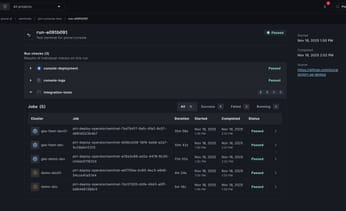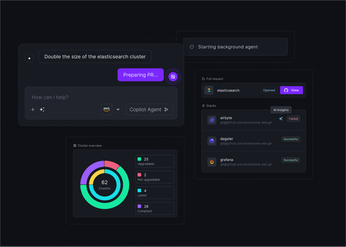
Kubernetes Headless Services Explained: Key Concepts and Examples
Understand Kubernetes headless service, its key concepts, and practical examples. Learn how it enables direct pod communication and benefits stateful applications.
Kubernetes offers a rich set of networking features, and understanding them is crucial for building robust and scalable applications. While standard Kubernetes services provide a convenient abstraction for accessing pods, sometimes you need more direct control. Enter Kubernetes headless services. A Kubernetes headless service allows your applications to communicate directly with individual pods, bypassing the service's load-balancing mechanism. This direct access unlocks new possibilities for stateful applications, peer-to-peer networking, and custom service discovery.
This comprehensive guide will explore the world of Kubernetes headless services, covering their definition, functionality, use cases, and best practices.
Unified Cloud Orchestration for Kubernetes
Manage Kubernetes at scale through a single, enterprise-ready platform.
Key Takeaways
- Direct pod access is the defining feature: Headless Services provide unique DNS records for each pod, enabling direct communication and bypassing Kubernetes' built-in load balancing. This is essential for applications requiring granular control over pod interactions, such as stateful sets and distributed databases.
- DNS resolution is critical: Headless Services applications rely on DNS to locate individual pods. Monitor DNS health and implement robust retry mechanisms in your application to handle potential resolution delays or failures.
- Load balancing requires a different approach: Headless Services don't provide load balancing. If your application requires this functionality, you must implement client-side load balancing or integrate with a service mesh.
What Are Kubernetes Headless Services?
Kubernetes Headless Services are a unique type of Kubernetes Service. They differ significantly from standard services in how they expose pods to the network. Understanding these differences is key to leveraging their power and flexibility.
Definition and Key Characteristics
A standard Kubernetes Service provides a stable, single IP address (ClusterIP) and acts as a load balancer for a set of pods. A Headless Service, however, does not allocate a ClusterIP. Instead, it exposes each pod through its own unique DNS record. This key difference lets applications directly address and communicate with specific pods, bypassing the service's built-in load balancing. This direct access is crucial for stateful applications, distributed databases, and other scenarios requiring fine-grained control over pod interaction.

Create and Configure Kubernetes Headless Services
Creating a Kubernetes headless service is straightforward. The key difference from standard services lies in the clusterIP setting. Let's walk through the process.
YAML Configuration Example
The core of your headless service is defined in a YAML file. This file specifies the service's properties, including the crucial clusterIP: None setting that distinguishes it as headless. Here's a basic example:
apiVersion: v1
kind: Service
metadata:
name: my-headless-service
spec:
clusterIP: None
selector:
app: my-app
ports:
- port: 80
targetPort: 8080
This configuration creates a headless service named my-headless-service. The selector ensures that the service targets pods with the label app: my-app. The ports section maps port 80 on the service to port 8080 on the target pods.
Step-by-Step Setup
- Create a YAML file: Save the YAML configuration (or a modified version) to a file, for example,
headless-service.yaml. - Apply the YAML file: Use the
kubectl applycommand to create the service:kubectl apply -f headless-service.yaml. - Verify creation: Confirm that the service was created successfully with
kubectl get service my-headless-service. You should see theclusterIPlisted asNone.
$ kubectl apply -f headless-service.yaml
service/my-headless-service created
$ kubectl get service my-headless-service
NAME TYPE CLUSTER-IP EXTERNAL-IP PORT(S) AGE
my-headless-service ClusterIP None <none> 80/TCP 7s
controlplane:~$ Verify Service Creation
Once the service runs, you can verify its headless nature through DNS resolution. When you query the DNS for your headless service, Kubernetes returns a list of the IP addresses of all pods backing the service. This direct access to pod IPs is the defining characteristic of a headless service, enabling clients to connect directly to individual pods without an intermediary load balancer. This direct pod access is fundamental to headless services and enables various use cases, such as stateful application management.
Key Use Cases of Kubernetes Headless Services
Stateful Applications and Databases
Headless services are particularly well-suited for stateful applications and databases deployed in Kubernetes. A traditional service with its load balancing mechanism can obscure the individual pod IPs, making it challenging to directly address and manage these stateful instances. Headless services solve this by enabling direct access to each pod via its unique DNS entry. This is crucial for applications like databases, where maintaining consistent connections to a specific pod is essential for data integrity and transaction management.
Microservices
In a microservices architecture, applications are broken down into smaller, independent services that communicate with each other. Headless services provide a mechanism for these services to discover and communicate directly with each other without relying on intermediary load balancers. This direct communication can improve performance and reduce latency, especially when services need to maintain persistent connections or exchange large amounts of data.
Custom Service Discovery
Headless services offer a powerful mechanism for implementing custom service discovery within Kubernetes. Because a headless service resolves to a list of pod IPs, you can integrate this DNS resolution into your application's service discovery logic. This allows you to build highly customized service discovery mechanisms tailored to your application's requirements. For instance, you could implement a client-side load balancing strategy where the client queries the DNS for the headless service and then selects a pod IP based on factors like geographic proximity, resource utilization, or application-specific criteria.
Advantages and Challenges of Kubernetes Headless Services
Benefits: Direct Communication and Unique Identities
Headless services offer distinct advantages when direct pod communication and unique identities are crucial. This direct pod communication is essential for stateful applications like databases or message brokers, where each pod holds unique state, and clients need to connect to specific pods. For instance, each node plays a particular role in a distributed database, and clients must connect to the correct node. Headless services facilitate this by providing a mechanism for clients to discover and connect to individual pods.
Drawbacks: Complexity and DNS Overhead
While headless services offer benefits, they also introduce complexities and operational overhead. One challenge is the increased reliance on DNS. Headless services depend on the proper functioning of the cluster's DNS service to resolve pod names to IP addresses. If the DNS service experiences issues or pod IPs change frequently due to rescheduling or scaling, it can disrupt communication and lead to application errors. Ensuring DNS stability and proper configuration is crucial for reliable operation.
Best Practices of Kubernetes Headless Services
When to Choose Headless Services
Headless Services are best suited for situations where your applications need direct access to individual pods, unlike standard services that offer an abstract endpoint. Consider them for:
- Stateful applications: StatefulSets depend on each pod's persistent, unique network identifiers. Headless Services deliver this, simplifying management of stateful applications like databases. For instance, a Cassandra database cluster requires distinct identities for each pod, which a Headless Service facilitates.
- Custom load balancing: If your application requires a tailored load balancing strategy beyond Kubernetes' default capabilities, Headless Services allow you to implement your own. Use the DNS records from the Headless Service to create a custom load balancer that directs traffic according to specific application needs.
- Microservices requiring direct pod access: Some microservice architectures require services to communicate directly with specific backend pods. Headless Services enable this by bypassing the service proxy.
A standard Kubernetes Service is likely a simpler and more efficient choice if these specific capabilities aren't necessary.
Related Articles
Unified Cloud Orchestration for Kubernetes
Manage Kubernetes at scale through a single, enterprise-ready platform.
Frequently Asked Questions
Why would I use a Headless Service instead of a regular Service? Regular services provide a stable IP address and handle load balancing, making them suitable for most applications. Headless Services are specifically for situations where you need direct access to individual pods, such as with stateful applications, custom load balancing, or microservices requiring direct communication. If you don't need this granular control, a standard service is generally simpler.
How does DNS resolution work with Headless Services? With a Headless Service, the service name acts as a domain. Each pod receives a unique DNS record in the format <pod-name>.<service-name>.<namespace>.svc.cluster.local. When a client queries the service name, it gets a list of all pod IPs, enabling direct connections.
Are Headless Services reliable, given their dependence on DNS? Headless Services rely on Kubernetes' internal DNS, which is typically robust. However, ensure your pods are stable. Frequent restarts can lead to DNS updates and brief resolution failures. Account for DNS propagation time and implement retry mechanisms in your applications.
Do Headless Services provide load balancing? Headless Services do not offer the same load balancing as regular services. While DNS often uses round-robin, it's not as sophisticated as kube-proxy. If you need advanced load balancing, you must implement it yourself, either client-side or with a service mesh.
How do Headless Services interact with StatefulSets? Headless Services are essential for StatefulSets. They provide each pod in a StatefulSet with a stable, unique DNS name, enabling direct access and simplifying management of stateful applications like databases. This allows for ordered deployments, persistent storage, and stable network identifiers, crucial for complex stateful applications.
Newsletter
Join the newsletter to receive the latest updates in your inbox.









